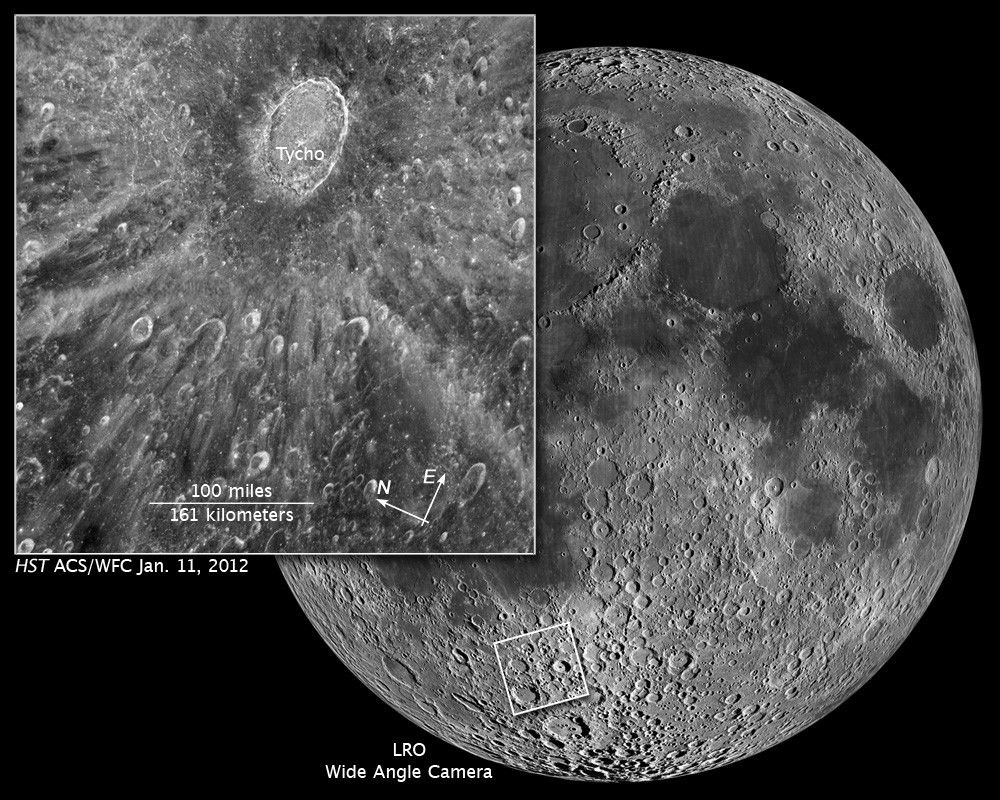1 min read
Crater Tycho on the Moon

This mottled landscape showing the impact crater Tycho is among the most violent-looking places on our Moon.
This image, taken with Hubble's Advanced Camera for Surveys, reveals lunar features as small as roughly 560 feet (170 meters) across. The large "bulls-eye" near the top of the picture is the impact crater, caused by an asteroid strike about 100 million years ago. The bright trails radiating from the crater were formed by material ejected from the impact area during the asteroid collision. Tycho is about 50 miles (80 kilometers) wide and is circled by a rim of material rising almost 3 miles (5 kilometers) above the crater floor. The image measures 430 miles (700 kilometers) across, which is slightly larger than New Mexico.
About the Object
- DistanceDistanceThe physical distance from Earth to the astronomical object. Distances within our solar system are usually measured in Astronomical Units (AU). Distances between stars are usually measured in light-years. Interstellar distances can also be measured in parsecs.Approximately 237,000 miles (381,000 km) at the time of observation.
About the Data
- Data DescriptionData DescriptionProposal: A description of the observations, their scientific justification, and the links to the data available in the science archive.
Science Team: The astronomers who planned the observations and analyzed the data. "PI" refers to the Principal Investigator.The image was created from Hubble data from proposal 12537: D. Ehrenreich (Institut de Planétologie et d’Astrophysique de Grenoble (IPAG)/CNRS/Université Joseph Fourier), L. Arnold (CNRS, Laboratoire d'Astrophysique de Marseille), A. Vidal-Madjar (CNRS, Institut d'Astrophysique de Paris), M. Barthelemy (Université de Grenoble I), I. Boisse (CNRS, Institut d'Astrophysique de Paris), F. Bouchy (CNRS, Institut d'Astrophysique de Paris), R. Cabanac (Observatoire Midi-Pyrénées), J.-M. Desert (Harvard University), R. Ferlet (CNRS, Institut d'Astrophysique de Paris), G. Gronoff (NASA Langley Research Center), G. Hebrard (CNRS, Institut d'Astrophysique de Paris), A. Lecavelier des Etangs (CNRS, Institut d'Astrophysique de Paris), J. Lilensten (Institut de Planétologie et d'Astrophysique de Grenoble), J. McConnell (York University), C. Moutou (CNRS, Laboratoire d'Astrophysique de Marseille), C. Nitschelm (Universidad Catolica del Norte), D. Kent Sing (University of Exeter). The primary objective of the program was spectroscopic observations with STIS to analyze sunlight reflected from the Moon. Images were obtained in parallel with ACS. - InstrumentInstrumentThe science instrument used to produce the data.HST>ACS/WFC
- Exposure DatesExposure DatesThe date(s) that the telescope made its observations and the total exposure time.January 11, 2012, Exposure Time: 0.5 seconds
- FiltersFiltersThe camera filters that were used in the science observations.F502N ([O III])
- Object NameObject NameA name or catalog number that astronomers use to identify an astronomical object.Moon, Tycho
- Object DescriptionObject DescriptionThe type of astronomical object.Crater on Earth's Moon
- Release DateMay 4, 2012
- Science ReleaseHubble to Use Moon as Mirror to See Venus Transit
- Credit

This is a black and white (grayscale) image from a single exposure acquired by the ACS instrument on HST. Gaps in the HST data have been filled using an image at similar lunar phase from the Consolidated Lunar Atlas.

Related Images & Videos

Hubble Shoots The Moon During Venus Transit
During the transit of Venus across the Sun's face on June 5-6, 2012, the Hubble Space Telescope will be looking in the opposite direction – at the Moon. Hubble cannot look at the Sun directly, so astronomers are planning to use the Moon as a mirror to capture reflected sunlight...
Share
Details
Claire Andreoli
NASA’s Goddard Space Flight Center
Greenbelt, Maryland
claire.andreoli@nasa.gov





























